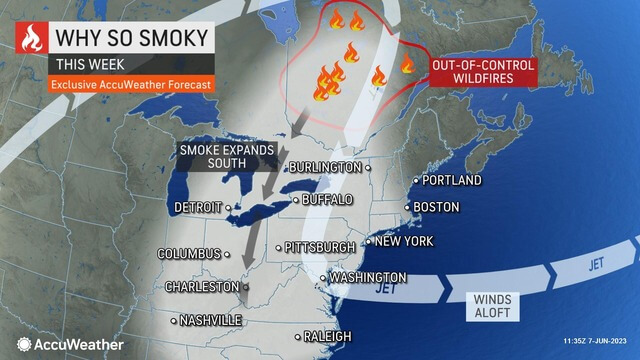Originally published by AccuWeather.
AccuWeather meteorologists assess the unusual outbreak of wildfire smoke blanketing the Northeastern US from distant Canadian wildfires to be the worst smoke outbreak in the Northeastern United States in more than 20 years! AccuWeather Chief Meteorologist Jonathan Porter said “as bad as the smoke and air pollution was on Tuesday, the air quality can be even worse at times across parts of the Northeast on Wednesday and poor air quality is expected to linger in some areas into the weekend.” Porter said “people should frequently check the AccuWeather exclusive Plume Labs air quality maps at https://www.accuweather.com/airquality and limit their time outdoors in areas with air pollution while using a high-quality N95 or KN95 mask if you must be outdoors. Indoors, sleeping with the windows closed and using an air conditioner or fan can be helpful, and using a HEPA filter can reduce the number of these small particles from the air.”
The smoke has been generated by numerous, large wildfires burning in the Canadian province of Quebec, and atmospheric winds are directing the smoke into parts of the Northeastern United States.
Unlike other wildfire smoke episodes in the Northeast, where the smoke was primarily present well above the ground, only resulting in hazy skies and more vivid sunrises and sunsets, the smoke in recent days has also been at a ground level resulting in poor air quality, low visibility, and serious health risks to people, especially those outdoors.
As accurately forecast by AccuWeather, air quality rapidly worsened in the corridor from the New York City area to Eastern Pennsylvania late Tuesday, with some air quality observation sites appearing to report their highest concentration of harmful particulate pollution in the air since 1999.
To underscore the health impacts – based on available research, AccuWeather estimates that breathing the polluted air in the worst impacted areas of the Northeast for several hours can result in breathing in the same level of harmful air as smoking 5-10 cigarettes!
The unusually poor air quality in the Northeast is extremely rare in modern times and is like the levels of air pollution frequently observed in other parts of the world without the same air pollution standards and restrictions, including China, India, Southeast Asia, and even into South America where this level of pollution can be common. Additionally, as bad as the smoke was in the Northeast, the air pollution was even more intense near wildfires in parts of the West in recent years – including the California Complex Fire in August 2020.
How long will it last? AccuWeather Director of Forecasting Operation Dan DePodwin said: “On Thursday and Friday, the worst smoke and related air quality is expected to shift west across the Great Lakes and parts of Ohio Valley and interior Northeast including the cities of Buffalo, Pittsburgh, and Detroit.”
He added, “Later this weekend into early next week, a storm moving through the Ohio Valley may cause the smoke to wrap westward across the Great Lakes and then southward through the Ohio Valley and into the mid-Atlantic. This behavior – where a storm “ingests” smoke and transports it far away from the fires – occurred in May with fires in Alberta and can result in a “smoke storm.”
Unfortunately, significant rain is not expected across the wildfire areas, although on-and-off showers can occur Thursday through Saturday, which may aid in fire-fighting efforts. A higher likelihood of meaningful rain is expected on Monday. The fires may burn for a significant period of time and continue to loft smoke, creating the opportunity for time periods where smoke can return to parts of the Eastern US over the coming weeks and even months.




